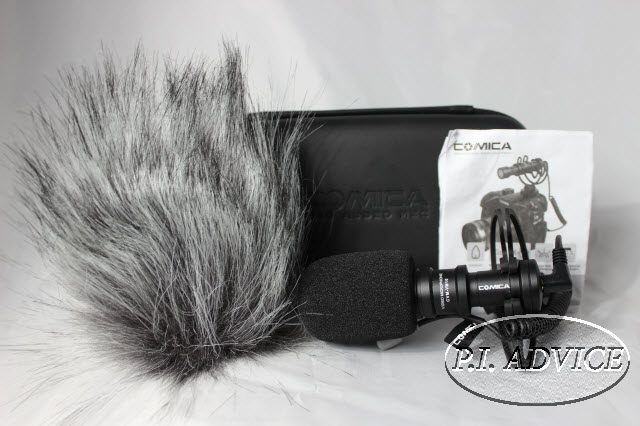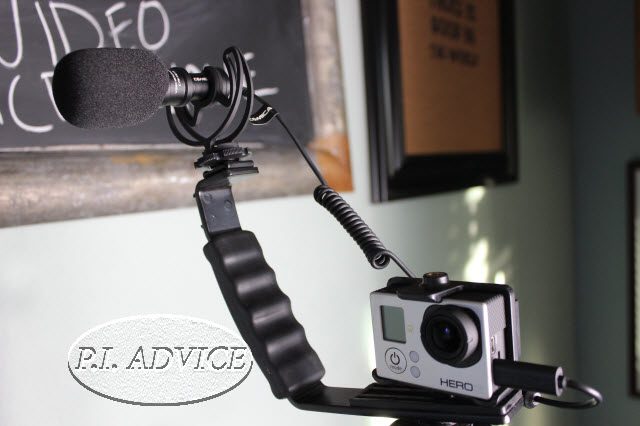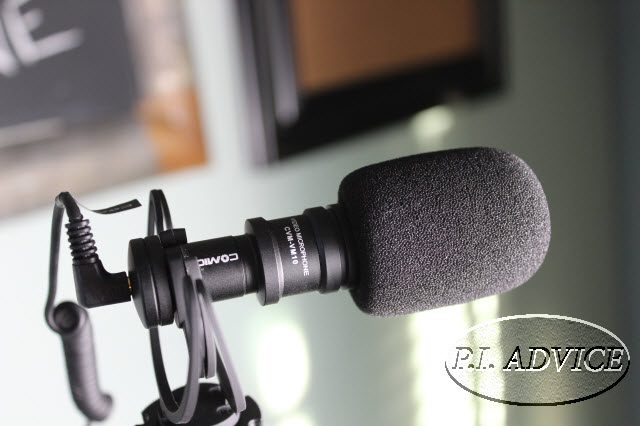Sometimes a video camera has limited microphone abilities that make a video sound unprofessional. Usually the further you are from a video camera the weaker the audio levels will become on a typical camcorder. This is why many people use external microphones on DSLR cameras, camcorders, cell phones and even action cameras like the GoPro Hero 3. Generally speaking, I try to use an external microphone of some sort when creating videos as to not sound far away from the camera or to not have hollow or echoing sounds in the audio of the video. With that being said I was very much interested in testing the Comica CVM-VM10 Cardioid Directional Shotgun Microphone with Shock-Mount on my devices to see how much better the audio quality would be with this microphone while making videos.
In this review I will discuss the following topics:
- What is in the Box?
- Design and Size
- Audio Quality
- Who the Comica CVM-VM10 Would Be Good For
- Concerns
- Final Thoughts
Contents
- 1 What is in the Box?
- 2 Design and Size
- 3 Audio Quality
- 4 What does Cardioid Directional mean?
- 5 What is a Shotgun Microphone?
- 6 Audio Quality for the Comica CVM-VM10
- 7 Comica CVM-VM10 Microphone With the GoPro
- 8 Sound with Wind Interference
- 9 Sound at a Distance
- 10 GoPro Tip
- 11 Comica CVM-VM10 Microphone With the Samsung Note 5
- 12 Who the Comica CVM-VM10 Would Be Good For
- 13 Concerns
- 14 Final Thoughts
What is in the Box?
Let me just say I was surprised and delighted to find that Comica provides a nice case that carries the device and attachments. It also secures portions of the microphone within the case in foam.
Inside the case you will find:
- 1- Comica CVM-VM19 Microphone
- 1- Foam mic cover
- 1- Deadcat Mic Cover (Wind Muff)
- 1-Smartphone audio cable
- 1-Camera Audio Cable
- 1-Carrying Case
- 1-Instruction Manual
- 1-Shock absorption mic stand

Design and Size
This microphone is pretty small and is comparable to Rode mini-microphone in size. The microphone is light and won’t add any significant weight to whatever you place it on.
Having a cold shoe on the bottom of shock absorption stand make it great to use with DSLR cameras with video capabilities.
Using this microphone with a GoPro or cell phone will require an additional mount to secure both the camera and microphone on. I will share some links to mounts later in this review.
I was able to attach the microphone onto my DSLR with no problem though my Canon T3i didn’t want to record when the audio cable was plugged into the camera. I don’t know why it didn’t work but I would only blame my camera, not the microphone.
Audio Quality
Before I discuss the audio quality I thought it first might be important to provide the definition of Cardioid Directional and what exactly a shotgun microphone is.
What does Cardioid Directional mean?
This microphone is Cardioid Directional and that basically means that it is more sensitive to sound in the direction that it is being pointed at. The microphone will be less sensitive towards the back of the microphone. This design is to eliminate ambient sound where the microphone is not pointed.
What is a Shotgun Microphone?
A shotgun microphone is a directional microphone used for recording sound at a distance so you don’t have to hold a microphone or wear a lavalier microphone.

Audio Quality for the Comica CVM-VM10
I was only able to test the microphone my Samsung Note 5 cell phone and my GoPro Hero 3. Below are my thoughts on each device.
Comica CVM-VM10 Microphone With the GoPro
After purchasing an audio adapter (which you will need to do if you don’t have one already for your GoPro) I was able to connect the microphone to my GoPro.
I was honestly surprised as to how much better the audio sounded once the microphone was attached. In the review video (to be posted soon) for the Comica CVM-VM10 you are able to hear a significant difference when the microphone is connected and ever more of a positive difference with the wind muff is covering the microphone.
Sound with Wind Interference
I blew on the wind muff and had a fan pointed at me during my review. With all things considered I thought the audio continued to sound pretty good while standing a couple feet away from the microphone.
Sound at a Distance
Another thing that I was very impressed by was how the Comica CVM-VM10 picked up my voice from over 5 feet away from the microphone and it still sounded clear. It definitely sounded better than the microphone on the camera itself.
GoPro Tip
In order to use the microphone and GoPro together, it is recommended that you use a small rig like the one pictured below to make for easy videotaping while using the GoPro and Comica CVM-VM10 Shotgun Microphone together. Here is the mount I was using for the microphone and GoPro Hero 3.
Comica CVM-VM10 Microphone With the Samsung Note 5
As I mentioned previously the microphone did not work with the stock video setup on my cell phone. The company did not suggest a specific app to use for this microphone when connecting it to a cell phone.
I downloaded the Open Camera app by Mark Harman and used it when recording video with the microphone connected to my phone and the microphone worked. The audio was significantly better when my phone was plugged into the microphone The only problem I had was that I didn’t have a smartphone video rig/mount to use when testing this. I do plan on purchasing one soon. Below are two that I found that you might be interested in.
Who the Comica CVM-VM10 Would Be Good For
In a general sense, a microphone is good for anyone that is looking for flexibility especially those wanting to record video with good audio quality and not carrying a large microphone around.
Many vloggers use these type of microphones for close-up video recordings because it takes less preparation to begin videotaping and the audio in the video is enhanced and more professional.
Private investigators could use this microphone for interviews that are recorded with video. This would also be good if investigators create videos for their private investigation business, website or YouTube channel.
I am sure you will find many more uses for this then I have mentioned and if you do, be sure to mention those ideas in the comment section.
Concerns
I was bummed out when I first opened the microphone and it didn’t immediately work on my phone. The manual said it only worked on Huawei phones and third-party app needed to be used to get the microphone to work with other types of phones. The problem is that they didn’t say exactly what app will work. I did find an app that worked with the microphone but I was worried at first that it was not going to work.
I wanted to test this microphone with my GoPro but I had to purchase a separate cable to connect the microphone to my GoPro. This might be something Comica can add to the package as an option so someone without the cable can get it working right away. With that being said, here is a link to the cable you will need to attach this camera to your GoPro Hero 3.
Final Thoughts
As I write this review this microphone is selling for $52.69 for Prime members which I believe is a pretty good deal considering the quality of audio it provides in such a compact microphone.
If you compare it to another well-known microphone, the Rode VideoMicro, you will see it is almost identical in appearance but slightly less expensive than the Rode VideoMicro.
My concerns listed above are not deal breakers and more of an inconvenience than anything. I know that I will be using this microphone to make more videos for you and I am excited to experiment more with it.
Let me know your experiences with the camera should you pick one up, or if you already have one. Below is the Amazon affiliate link to this microphone.
If you know of another microphone worth testing please let me know in the comment section.
Andrew
Recent Posts
Hawaii is probably one of the most interesting states to work as a private investigator if you are not used to the culture or a native of the state. And if you are not a local, that is something...
How to become a private investigator in Georgia





